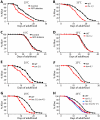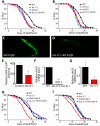Regulation of the longevity response to temperature by thermosensory neurons in Caenorhabditis elegans
- PMID: 19375320
- PMCID: PMC2868911
- DOI: 10.1016/j.cub.2009.03.041
Regulation of the longevity response to temperature by thermosensory neurons in Caenorhabditis elegans
Erratum in
- Curr Biol. 2009 May 12;19(9):798
Abstract
Background: Many ectotherms, including C. elegans, have shorter life spans at high temperature than at low temperature. High temperature is generally thought to increase the "rate of living" simply by increasing chemical reaction rates. In this study, we questioned this view and asked whether the temperature dependence of life span is subject to active regulation.
Results: We show that thermosensory neurons play a regulatory role in the temperature dependence of life span. Surprisingly, inhibiting the function of thermosensory neurons by mutation or laser ablation causes animals to have even shorter life spans at warm temperature. Thermosensory mutations shorten life span by decreasing expression of daf-9, a gene required for the synthesis of ligands that inhibit the DAF-12, a nuclear hormone receptor. The short life span of thermosensory mutants at warm temperature is completely suppressed by a daf-12(-) mutation.
Conclusions: Our data suggest that thermosensory neurons affect life span at warm temperature by changing the activity of a steroid-signaling pathway that affects longevity. We propose that this thermosensory system allows C. elegans to reduce the effect that warm temperature would otherwise have on processes that affect aging, something that warm-blooded animals do by controlling temperature itself.
Figures








Comment in
-
Aging: shall we take the high road?Curr Biol. 2009 May 12;19(9):R363-4. doi: 10.1016/j.cub.2009.03.040. Curr Biol. 2009. PMID: 19439256 Review.
Similar articles
-
Aging: shall we take the high road?Curr Biol. 2009 May 12;19(9):R363-4. doi: 10.1016/j.cub.2009.03.040. Curr Biol. 2009. PMID: 19439256 Review.
-
Influence of steroid hormone signaling on life span control by Caenorhabditis elegans insulin-like signaling.G3 (Bethesda). 2013 May 20;3(5):841-50. doi: 10.1534/g3.112.005116. G3 (Bethesda). 2013. PMID: 23550118 Free PMC article.
-
Caenorhabditis elegans EAK-3 inhibits dauer arrest via nonautonomous regulation of nuclear DAF-16/FoxO activity.Dev Biol. 2008 Mar 15;315(2):290-302. doi: 10.1016/j.ydbio.2007.12.032. Epub 2008 Jan 3. Dev Biol. 2008. PMID: 18241854 Free PMC article.
-
A C. elegans Thermosensory Circuit Regulates Longevity through crh-1/CREB-Dependent flp-6 Neuropeptide Signaling.Dev Cell. 2016 Oct 24;39(2):209-223. doi: 10.1016/j.devcel.2016.08.021. Epub 2016 Oct 6. Dev Cell. 2016. PMID: 27720609
-
Regulatory systems that mediate the effects of temperature on the lifespan of Caenorhabditis elegans.J Neurogenet. 2020 Sep-Dec;34(3-4):518-526. doi: 10.1080/01677063.2020.1781849. Epub 2020 Jul 7. J Neurogenet. 2020. PMID: 32633588 Review.
Cited by
-
Co-chaperone p23 regulates C. elegans Lifespan in Response to Temperature.PLoS Genet. 2015 Apr 1;11(4):e1005023. doi: 10.1371/journal.pgen.1005023. eCollection 2015 Apr. PLoS Genet. 2015. PMID: 25830239 Free PMC article.
-
Caenorhabditis Sieve: A Low-tech Instrument and Methodology for Sorting Small Multicellular Organisms.J Vis Exp. 2018 Jul 4;(137):58014. doi: 10.3791/58014. J Vis Exp. 2018. PMID: 30035770 Free PMC article.
-
Regulation of life span by mitochondrial respiration: the HIF-1 and ROS connection.Aging (Albany NY). 2011 Mar;3(3):304-10. doi: 10.18632/aging.100292. Aging (Albany NY). 2011. PMID: 21389351 Free PMC article. Review.
-
Positive and negative gustatory inputs affect Drosophila lifespan partly in parallel to dFOXO signaling.Proc Natl Acad Sci U S A. 2014 Jun 3;111(22):8143-8. doi: 10.1073/pnas.1315466111. Epub 2014 May 20. Proc Natl Acad Sci U S A. 2014. PMID: 24847072 Free PMC article.
-
OASIS: online application for the survival analysis of lifespan assays performed in aging research.PLoS One. 2011;6(8):e23525. doi: 10.1371/journal.pone.0023525. Epub 2011 Aug 15. PLoS One. 2011. PMID: 21858155 Free PMC article.
References
-
- Klass MR. Aging in the nematode Caenorhabditis elegans: major biological and environmental factors influencing life span. Mech Ageing Dev. 1977;6:413–429. - PubMed
-
- Pearl R. The Rate of Living. University of London Press; London: 1924.
-
- Zimmerman WF, Pittendrigh CS, Pavlidis T. Temperature compensation of the circadian oscillation in drosophila pseudoobscura and its entrainment by temperature cycles. J Insect Physiol. 1968;14:669–684. - PubMed
-
- Wheeler DA, Hamblen-Coyle MJ, Dushay MS, Hall JC. Behavior in light-dark cycles of Drosophila mutants that are arrhythmic, blind, or both. J Biol Rhythms. 1993;8:67–94. - PubMed
Publication types
MeSH terms
Substances
Grants and funding
LinkOut - more resources
Full Text Sources
Other Literature Sources
Miscellaneous

